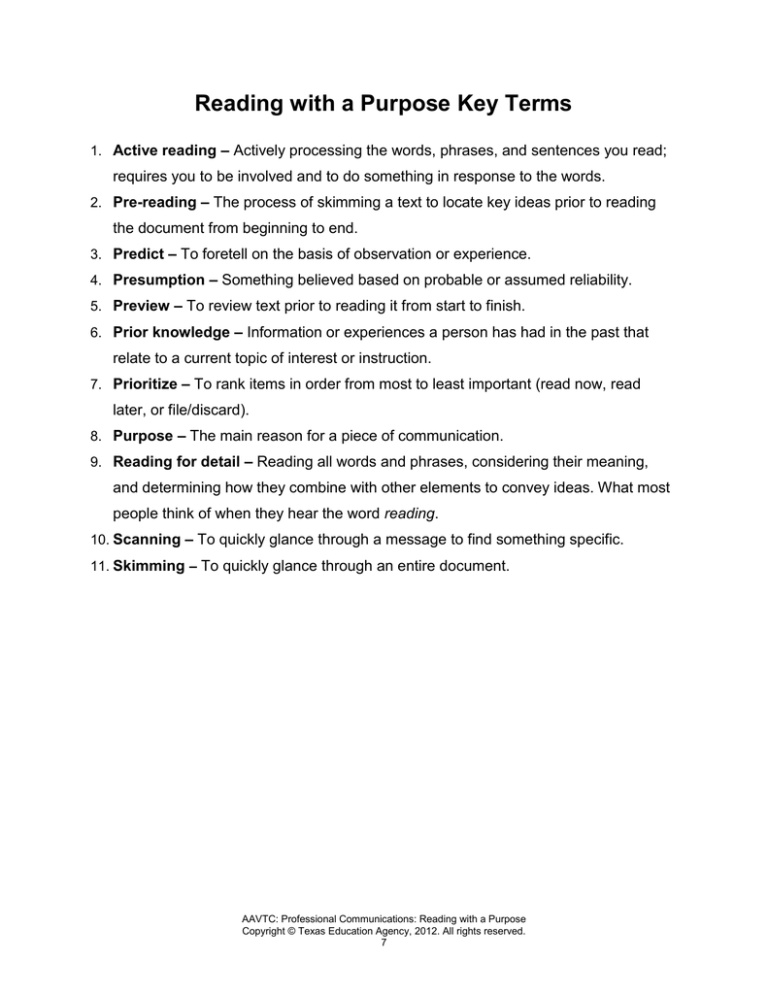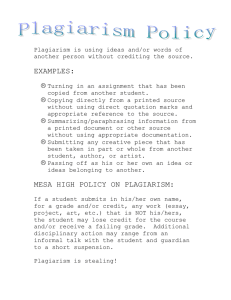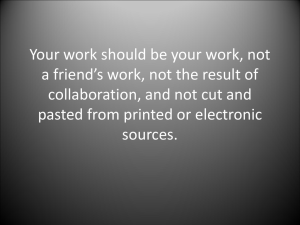
Reading with a Purpose Key Terms
1. Active reading – Actively processing the words, phrases, and sentences you read;
requires you to be involved and to do something in response to the words.
2. Pre-reading – The process of skimming a text to locate key ideas prior to reading
the document from beginning to end.
3. Predict – To foretell on the basis of observation or experience.
4. Presumption – Something believed based on probable or assumed reliability.
5. Preview – To review text prior to reading it from start to finish.
6. Prior knowledge – Information or experiences a person has had in the past that
relate to a current topic of interest or instruction.
7. Prioritize – To rank items in order from most to least important (read now, read
later, or file/discard).
8. Purpose – The main reason for a piece of communication.
9. Reading for detail – Reading all words and phrases, considering their meaning,
and determining how they combine with other elements to convey ideas. What most
people think of when they hear the word reading.
10. Scanning – To quickly glance through a message to find something specific.
11. Skimming – To quickly glance through an entire document.
AAVTC: Professional Communications: Reading with a Purpose
Copyright © Texas Education Agency, 2012. All rights reserved.
7
Guided Practice Anticipation Guide
Student Name:
Agree/Disagree
_____
Date:
Statement
1. Males are better problem solvers than
females.
_____
2. A person’s self-concept increases as
he/she gets older.
_____
_____
3. People with a strong self-concept tend to
do better in school.
_____
_____
4. Females feel better about themselves than
males do.
_____
_____
_____
_____
_____
_____
5. Emotional Intelligence is the ability to think
about and react appropriately to our
emotions.
6. People with a high self-concept tend to set
more challenging goals for themselves.
7.
_____
_____
8.
_____
_____
9.
_____
_____
10.
_____
_____
11.
_____
_____
12.
_____
_____
AAVTC: Professional Communications: Reading with a Purpose
Copyright © Texas Education Agency, 2012. All rights reserved.
8
Evidence
Independent Practice Anticipation Guide
Student Name:
Agree/Disagree
_____
Date:
Statement
1. Copyright guidelines do not apply to
education.
_____
_____
_____
_____
_____
_____
_____
_____
_____
_____
_____
2. Sonny Bono, who used to be married to
Cher, worked in Congress to pass
legislation related to copyright.
3. If someone steals your copyrighted work,
you can file a copyright infringement
lawsuit against him/her.
4. Media that is online is part of the public
domain and is free for anyone to use.
5. If you buy a music CD or a piece of
software, you can use it in any way you
want.
6. Copyright is a legal tool that people use to
protect their ideas.
7. A quick sketch on a napkin is protected by
copyright.
_____
_____
_____
_____
_____
_____
8. If you are delivering a presentation in class
you can make enough copies of copyrightprotected work to give one copy to each of
your classmates.
9.
10.
_____
_____
11.
_____
_____
12.
_____
_____
AAVTC: Professional Communications: Reading with a Purpose
Copyright © Texas Education Agency, 2012. All rights reserved.
9
Evidence
Independent Practice Reading Assignment
Introduction
Copyright laws affect our lives in numerous ways. This is particularly true in the Arts, A/V
Technology & Communications Cluster, where students are involved in the creation, production,
duplication, and distribution of work using various media. Everyone needs to be aware of the
copyright laws and the need to abide by them.
Academic integrity and intellectual property
Academic integrity is a cross-disciplinary topic addressed by the College Readiness Standards,
adopted by the Texas Higher Education Coordinating Board on January 24, 2008. According to
those standards, students are expected to (1) attribute ideas and information to source
materials and people; (2) evaluate sources for quality of content, validity, credibility, and
relevance; and (3) understand and adhere to ethical codes of conduct, including following
copyright laws and restrictions, and using technology responsibly.
Intellectual property refers to “creations of the mind,” and represents intangible property.
Copyrights, patents, and trademarks are forms of intellectual property. A copyright protects
original works of authorship, while a patent protects inventions or discoveries. A trademark
protects words, phrases, symbols, or designs, identifying the source of the goods or services of
one party, and distinguishing them from those of others. Copyright is a legal tool that people use
to protect their creations from other people taking them and claiming them as their own.
Legislation
Established by the Copyright Act of 1976, copyright protection for works created prior to January
1, 1978, lasts 75 years from the date of publication. Works created by an individual after
January 1, 1978, are protected by copyright for the lifetime of the author plus fifty years.
Copyright protection is set at 75 years for a work of corporate authorship under this act.
The Sonny Bono Copyright Term Extension Act extends the Copyright Law of 1976. Under the
Sonny Bono Act, copyright of private works is extended by 20 years. During his tenure in
politics, Sonny Bono petitioned to extend the timeframe of copyright protection. Although his
original bill was never voted on, a similar bill was passed in 1998 after his death and was named
in his honor. Under the Sonny Bono Act, works created by an individual prior to January 1,
1978, are protected by copyright for 95 years from the date of publication. Works created by an
individual after January 1, 1978, are protected by copyright for the lifetime of the creator plus 70
years.
What is not protected by copyright
Copyright does not protect ideas, facts, systems, or methods of operation. Copyright does not
protect names, titles, slogans, or short phrases; though in some cases, these things may be
protected as trademarks. Ideas in writing, or drawings, may be protected by copyright, but
copyright will not protect the idea itself as revealed in the written or artistic work.
Copyright registration
Work is under copyright protection the moment it is created and fixed in a tangible form, or that
it is perceptible either directly or with the aid of a machine or device. Registration of copyright is
NOT required to protect an expression. Registration of copyright, however, DOES secure a
public record of the copyright claim, and is necessary in order for the owner to file a copyright
infringement lawsuit.
AAVTC: Professional Communications: Reading with a Purpose
Copyright © Texas Education Agency, 2012. All rights reserved.
10
Public domain
In some cases media is free and accessible for anyone’s use. Works of this nature are
considered part of the public domain. Public domain applies to work that was created before
1923 (never covered by copyright law), work that is government property, and work that has an
expired copyright. Additionally, an author or artist may choose to place his or her work in the
public domain by including a statement of intent as part of the published work. An example of
work that has been placed in the public domain by the copyright owner can be found in image
citations on websites such as Wikipedia.
You can enter the Wikipedia link in this paragraph in your online browser to view an entry on
Fallingwater, a house designed by Frank Lloyd Wright (http://en.wikipedia.org/wiki/Fallingwater).
Click on any of the images of the house on that page and look at the copyright
permissions/licensing information. Though each image licensing statement is a little different,
most images are part of the public domain, either because they were taken by government
employees or because the owner placed them in the public domain.
Royalty free
In some cases media may be used in exchange for a fee payment. Media is considered “royalty
free” when a contract is created between the media owner and someone who wants to use the
media. The contract allows works such as photographs, animations, songs, videos, etc. to be
used without having to pay on-going royalties to the creator. The contract usually requires a
one-time fee.
Plagiarism
Plagiarism occurs when a person uses someone else’s ideas and claims them as his or her
own. Whether plagiarism involves a portion or the entirety of the other person’s creation,
plagiarism violates copyright laws. In a school setting, plagiarism is considered academic
dishonesty and can lead to expulsion from the school. The news will occasionally report trials
where a person is accused of stealing someone else’s work. The punishment for these types of
crimes often includes hefty fines and/or jail time.
Fair use guidelines
Fair Use is a doctrine in the U.S. which allows limited use of copyright protected information
without the permission of the author, creator, or publisher. Uses of material which typically fall
under the Fair Use guidelines are scholarly research and review of material prior to purchase.
Most people are aware that copyright law applies to print materials, but do not know the specific
guidelines for use. If the printed materials are being used in a classroom and meet the following
guidelines for fair use, then they can be used in the classroom:
Short printed materials less than 250 words or 250 words of larger materials
10% of printed materials with 1,000 words or more
Archived printed materials in their entirety
Single images or illustrations – no more than five copies
Online with its unlimited resources are being used more frequently in the classroom. With the
increased usage there is a mistaken belief that the resources are free. In fact, most resources
are not free and must be purchased. If something is used from online, it is a good rule of thumb
to always give credit.
AAVTC: Professional Communications: Reading with a Purpose
Copyright © Texas Education Agency, 2012. All rights reserved.
11
Understandably, students like to add songs to their multimedia presentations or other projects.
According to copyright and fair use guidelines, up to 10%, or no more than 30 seconds, of a
musical work can be used for educational purposes in multimedia programs.
Computer software is another copyrighted source that is frequently misused. The thought on
computer software is that if it has been purchased, then it can be loaded on to any computer
that is owned or used by the purchaser. Computer software is limited by the number of
installations that are in the license agreement. Users are required to abide by the licensing
agreement. The owner may make a single backup copy of the software in the event of damage
or loss. Libraries may be willing to assist you in creating backup copies for a fair price.
Items from online follow the same guidelines as music, printed materials, and videos. Online
resources cannot be reposted without permission, and they have to be acquired legitimately to
be used in educational presentations.
Conclusion
Copyright is designed to protect the rights of EVERY author, creator, and publisher. Students
are bound by the same copyright and fair use policies as non-students. If plagiarism occurs it is
deemed academic dishonesty and could result in expulsion from school. If you are reading this,
do not tell anyone. You can only receive the special grade if you do not tell anyone. You
must quietly and carefully let Mr. Ray know that you have seen this comment. If you do, you
will receive a grade of one hundred percent. Remember, tell no one. Most importantly,
copyright protects your work from misuse by others!
AAVTC: Professional Communications: Reading with a Purpose
Copyright © Texas Education Agency, 2012. All rights reserved.
12



